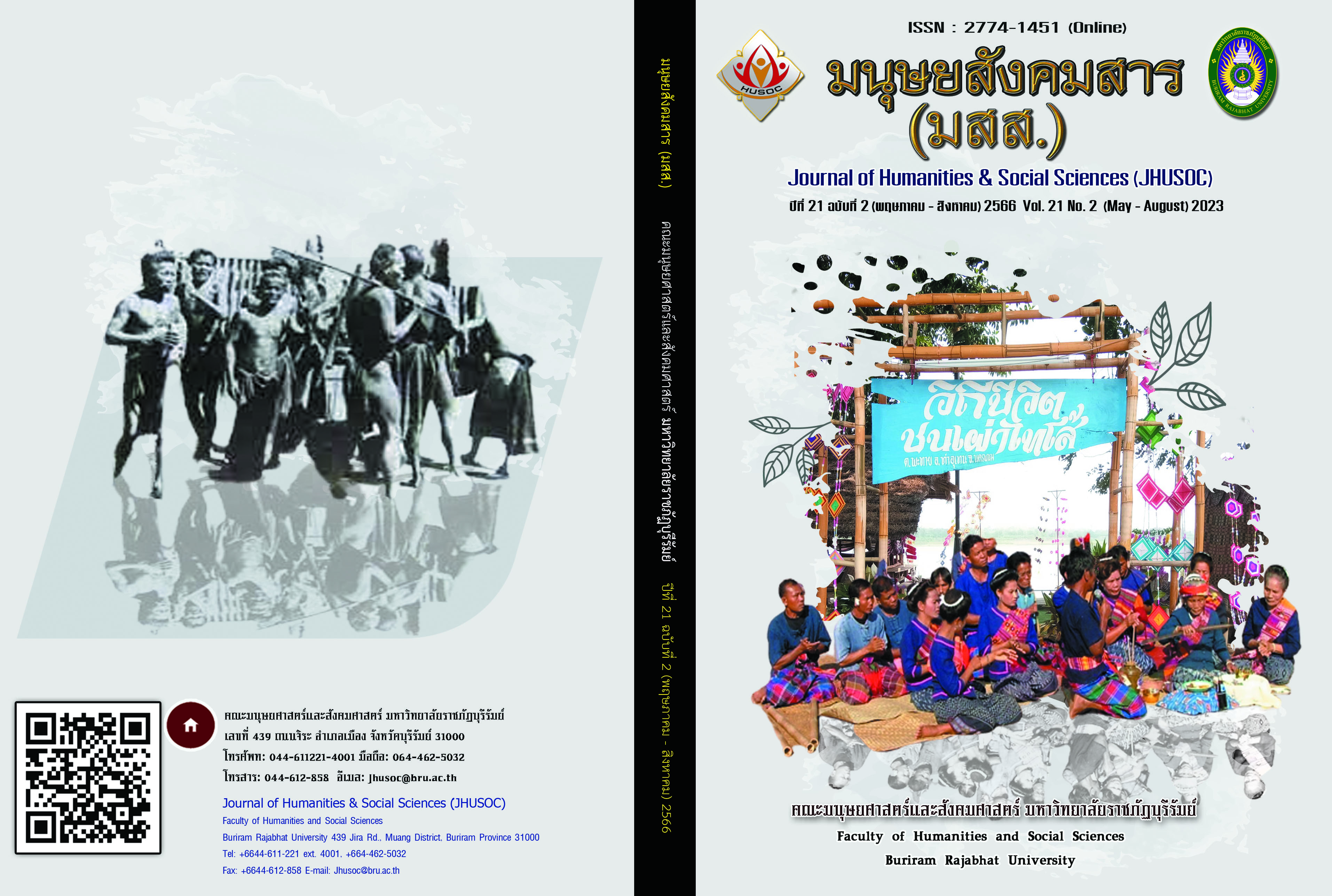Way of life of the people appeared in the folk tales entitled “Nang Sib Song”
Main Article Content
Abstract
The objective of this article was to study the way of life of the people appeared in the folk tales entitled “Nang Sib Song” in ASEAN. The folk tales used for analysis consisted 4 Thai folk tale versions, 1 Cambodian folk tale version, 1 Lao folk tale version, and 1 Burmese folk tale version. The study showed that: 1) The similarities fond in the way of life about the livelihood that appears in the folk tales entitled “Nang Sib Song” in ASEAN comprise of fishing, finding fruit, finding firewood, sugarcane cultivation, and rice cultivation. However, the study also found the differences in the way of life about the livelihood that appears in the folk tales entitled “Nang Sib Song” in the Thai, Lao, and Burmese versions as follows: cattle raising and betel nut eating in the Thai versions; weaving in the Lao version; and water resource finding in the Burmese version. 2) The way of life about family and association that appears in the ASEAN folk tales entitled "Nang Sib Song" is similar in terms of cockfighting and family food cooking. On the other hand, the differences in the way of life about family and association that appear in the folk tales entitled “Nang Sib Song” in the Thai, Lao, Cambodian, and Burmese versions are as follows: Sca playing, merit making, and cart driving in the Thai versions, Len Huean Noi (playing a seller) in the Lao version, Saba playing in the Cambodian version
Article Details

This work is licensed under a Creative Commons Attribution-NonCommercial 4.0 International License.
เนื้อหาและข้อมูลในบทความที่ลงตีพิมพ์ในวารสารทดสอบระบบ ThaiJo2 ถือเป็นข้อคิดเห็นและความรับผิดชอบของผู้เขียนบทความโดยตรงซึ่งกองบรรณาธิการวารสาร ไม่จำเป็นต้องเห็นด้วย หรือร่วมรับผิดชอบใดๆ
บทความ ข้อมูล เนื้อหา รูปภาพ ฯลฯ ที่ได้รับการตีพิมพ์ในวารสารทดสอบระบบ ThaiJo2 ถือเป็นลิขสิทธิ์ของวารสารทดสอบระบบ ThaiJo2 หากบุคคลหรือหน่วยงานใดต้องการนำทั้งหมดหรือส่วนหนึ่งส่วนใดไปเผยแพร่ต่อหรือเพื่อกระทำการใดๆ จะต้องได้รับอนุญาตเป็นลายลักอักษรจากวารสารทดสอบระบบ ThaiJo2 ก่อนเท่านั้น
References
Buddhasenkajataka. (n.d. N.P. n.p.)
Bronislaw Malinowski (1954). Magic, science and religion. Doubleday, Garden City, N.Y.
Chaiklam, S., Leepreecha, S., Sarethee, N., & Wangwok, N. (2020). The lifestyle and roles that appear in the Hmong hill tribe folk tales. Huai Nam Khao Village, Khek Noi, Khao Kho District, Phetchabun Province. Journal of Humanities and Social Sciences, University of Phayao, 8(2), 251-270. [in Thai]
Chuenka, R., Sereechaikul, T., & Suphan, J. (2017). Nang sip song (the twelve sisters) or Phra rot meri and its transmission as a shared folktale among countries in south east Asia. Bangkok. [in Thai]
Hongsuwan, P. (2009). Lanna buddha image: Ancient legend with identity construction and community power. Journal of Liberal Arts, Ubon Ratchathani University, 5(2), 5-37. [in Thai]
Kasempholkul, A. (2009). Phra Rot – Meri in folk tale: National intangible cultural heritage. Bangkok: Department of Cultural Promotion. [in Thai]
Kanparit, S., Meesantan, C., & Phumplab, M (2017). Asean roots. Bangkok: Department of Social Development and Welfare, Ministry of Social Development and Social Security. [in Thai]
Kiewkae, J. (2004). Thai Rural life in country music. Nakhon Pathom Rajabhat University: Nakhon Pathom. [in Thai]
Krusri, B. (1994). Comparison of students' achievement in folklore 1st grade by using role-playing and using folk songs. (Master's thesis). Bangkok: Chulalongkorn University. [in Thai]
Naichit, J. (2007). A study of traditions on the Lao Soong way of life. Don Kha Subdistrict, Bang Phae District, Ratchaburi Province. (Master of Arts Thesis, Thai Studies). Bangkok: Ramkhamhaeng University. [in Thai]
Ministry of Education. (n.d.). Phra Ratsen (Luang Si Amorn) from Thai Storybook. n.d. Bangkok: Ministry of Education. [in Thai]
Narto, P. (n.d.). Nang Sib Son. N.P. n.p.
Phumplab, M., Meesantan, C., & Kanparit, S. (2017). Asean roots. Bangkok: Department of Social Development and Welfare, Ministry of Social Development and Social Security. [in Thai]
Pongpaiboon, S. (n.d.). Thaksin Literature: Selected Literature, Volume 8, Suratthani Rajabhat University. [in Thai]
Poungkaew, N. (1984). A comparative study of various versions of Phra Rot – Meri. (Master Thesis, Department of Thai). Bangkok: Chulalongkorn University. [in Thai]
Prince Buddhasan and Queen Kong Ren. (n.d. n.p.)
Sunthornpong, E. (1985). Tales and storytelling. Bangkok: Department of Library Science, Faculty of Humanities, Srinakharinwirot University. [in Thai]
Thammawat, J. (1999). Orphan tales: Reflections of people's lives with restricted opportunities and ethnic relationships in the middle southeast region. Bangkok: Senior research scholar foundation. The Thailand Research Fund. [in Thai]
The Legend of Mong Nai Vertion of Nang Sib Song (the Twelve Sister). (2017). N.P. n.p.
Wasi, P. (2004). Development must need culture as a core. Bangkok: Division of Cultural Promotion, Office of National Culture Committee, Ministry of Culture. [in Thai]
Wongsavadee, K. (2023). Nang Sib Song. N.P. n.p.


